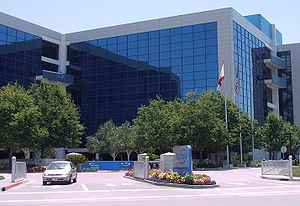| The headquarters of Intel Corporation in Santa Clara, California. Note the small "No Photos" sign in the picture. Photographed by user Coolcaesar on July 16, 2006. (Photo credit: Wikipedia) |
The comment makes since to those who only look at the surface and say it will create more jobs which almost every area could use. However, looking below the surface so called economic development has become a $50 Billion a year business. That's right cities, counties, states and the feds spend upwards of $50 Billion trying to get a business to move to a certain area.
The problem is, in our new global society our cities have become disposable, as soon as the tax incentives have expired the corporation will start demanding more money or just pick up and leave the area. If there is a good balance of business in the area it is not so devastating but when they are the major employer, the effects of a pull out can be long lasting. The subsidies themselves can take multiple forms including tax breaks, infrastructure improvements, or outright cash. Either way this incentives cost the area money and often times fail in the long run to be worth what was paid.
Let me give you some examples of economic incentives gone wrong:
-One city gives $300 million in subsidies to a major airline to create a maintenance base. Over the life of the base it employed half the number of employees promised and when the subsidy period ended the airline contracted out maintenance to another company who received other forms of incentives over the years.
-Another city gives subsidies to a major computer manufacturer to locate a manufacturing facility and call center. In a interesting twist the company lays off the employees before a deadline which means they would have to pay back all the subsidies they received so they have to quickly hire back employees and pay them to do nothing for two months before laying them off again.
-One city subsidizes a major corporation to leave the city center and move to the outer suburbs (these moves are usually designed to move the company closer to the current CEO and don't benefit the average employees or usually the companies for that matter). The area has only limited transit service because there is nothing else out there which causes more subsidies for highway and street expansions. The company has been in financial troubles for years but when the company starts "shopping" to move pressure is put on the governor of the state to give the company more subsidies. This also shows how desperate or corrupt some of these economic development teams are when they are willing to extended so much subsidies to a company that has been on the brink of failure for several years.
-Some cities have spent more than one million dollars per potential job created. However, in the long run the amount of payroll dollars never makes up for the amount of subsidies give to the business.
These are just four examples of what can go wrong when it comes to economic development.
Sports teams are another subsidy black hole. How often do you see some sport team that is telling the city you give us something or we are moving. The are always quick to point out the "multiplier" affect but of course leave out the other side of the equation which I will talk about separately.
Often times when discussing economic development you will hear the term "multiplier". This means that for every direct job created so many secondary jobs are created because that job was created. However, what often is not discussed whether it be a sports team or retailer is while they may create jobs there, it often comes at the expense of something. If you read the economic forecast for a sports team you will hear glowing things about the economic impact as if those attending the games just have this money sitting around to go to these high priced games or races. However, if a person decides to go to a major sporting event, it means that they have an opportunity cost for that event which says that they will not do something else. So the stadium may make the money but the movie theater looses, or they may reduce the number of times they go out to dinner. Often times since people come from the surrounding area, the city that has the stadium benefits and some other area looses so it is not quantified.
The same thing goes when a government agency gives subsidies to retailers such as Wal-Mart, Ikea, Cabela's and many others who get subsidies to locate in a certain place. While the city itself gets new retail dollars (unless of course they city is big enough that they are just paying Peter to rob Paul), those dollars come from somewhere and it means they don't shop somewhere else. For example a new store goes in at city A but it robs sales dollars from city B and C. The same dollars get spent, it just moved from one city to another.
The problem is, it is often small businesses that end up subsidizing major corporations that end up causing the small business to close. Of course this is no different than when the streetcar companies were heavily taxed and those tax dollars subsidized their competition back in the first half of the 20th century.
The trouble is, has the state of economic development incentives become too big of a monster to slay?











1 comment:
Good article, good article!
Post a Comment